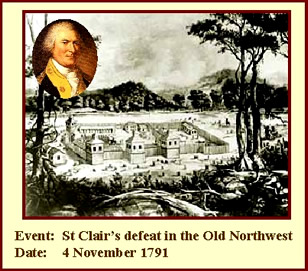4-10 November 1791
St Clair’s defeat in the Old Northwest
Early in 1791, Maj. Gen. Arthur St. Clair, Territorial Governor of the Old Northwest, began planning a major campaign against Indians in the Ohio Valley. Plagued by logistical problems, mismanagement, poor leadership, and inadequate support, St Clair’s venture had disaster written all over it.
 His newly appointed field Quartermaster, Samuel Hodgdon, relied on private contractors to procure supplies in the East, for movement down the Ohio River to Fort Washington (present-day Cincinnati) where Army regulars and short-term militiamen were rendezvousing. But the system failed miserably.
His newly appointed field Quartermaster, Samuel Hodgdon, relied on private contractors to procure supplies in the East, for movement down the Ohio River to Fort Washington (present-day Cincinnati) where Army regulars and short-term militiamen were rendezvousing. But the system failed miserably.
With contracts going to low-bidders the troops ultimately got tents that leaked, clothing that wore out in no time, shoes that were “vile in the extreme,” and powder so weak it would carry a ball only a short distance. Both men and animals also lacked the subsistence to stay healthy. Nor were there enough tools to clear the wilderness trail and build the forts, such as Fort Hamilton (pictured) needed along the way.
On 4 November 1791, a group of Miami Indians surprised St Clair’s hapless force as it camped along the Wabash. Of the 1,400 troops engaged, more than 600 were killed, and only 500 escaped unhurt. This campaign still figures to be among the worst defeats in the history of the United States Army.
Compiled by Dr. Steven Anders, former Quartermaster School historian.
Quote of the Week:
Only the study of military history is capable of giving those who have no experience of their own a clear picture of what I have just called the friction of the whole machine.— Clausewitz, Principles of War (1812)
